By John T. Houlihan
September 25, 2014
Published by permission
It was a hot and muggy summer in July of 1968 in the Detroit area. My good friend and college roommate was in the Navy and being transferred from the Mediterranean to the South China Sea off the coast of Vietnam. He stopped by on his way to San Francisco for a brief visit. We commiserated over several beers that evening. He had to leave early the next morning and I had to go into work.
I was an exterior designer for the General Motors Corporation working in the GM Styling department at the GM Tech Center on Mound Rd in Warren Michigan. This was my first job out of college and a prestigious one at that. GM Styling was recognized as the pinnacle of American automotive styling. By the summer of ’68 I was into my third year as a designer.
That day was important because I was finishing a full size air brush rendering that I had convinced the studio chief designer needed to be included in the array of proposals which were to be shown to the GM “brass” that day. The studio where this was taking place was the Advanced Chevrolet studio. We were working on the XP-887.
GM had been considering the introduction of another “small” car after the Corvair project ran into trouble following bad press years earlier due to Ralph Nader’s book Unsafe at Any Speed book which panned the car’s design as being inherently unsafe. This new small car needed to be a “world beater” to restore GM’s reputation and to gain further market share in, what was believed to be, a growing demand for smaller, economical vehicles.
The earlier designs for the XP-887 project were rejected by the corporate management team assigned to this effort as being too “GM looking.” The new direction needed to be “European” in look and feel. Advanced Chevy Studio was assigned this project.
Large photos of the Fiat 124 were placed all around the studio as inspiration. The engine for the XP-887, already under development for a few years, was actually placed into a Fiat 124 for testing at the Milford Proving Ground. The designers were encouraged to research European cars so as to get feel of that aesthetic.
Despite all this effort to “Europeanize” the design, the real influence for the XP 887 was the current design effort for the new 1970 Camaro. That design was taking place in another Advanced Chevy studio under the direction of Hank Haga. That design was stunning.
I had the opportunity to visit the studio where the Camaro design was taking place and saw a full size perspective rendering of a wagon version of the new Camaro. It was awesome. Not only was the full sized air brushed rendering in perspective, it was a breathtaking design. It left a deep and lasting impression on me. I had to take this back to our studio and create a wagon version for the XP-887.
It was not easy to convince my boss to allow this excursion in a new direction since the company was not planning on tooling a wagon. In fact the basic plan called for a hatchback and possibly a sedan type (ultimately called a notchback) version. No wagon planned.
Since I was willing to do this on my own time the boss relented. I worked on this after hours for a few nights and a weekend. Thus, this fateful day arrived and I was compromised in that I had been up most of the night with my friend on his way to dangerous assignment.
That dawn I dragged myself out of bed said a sad goodbye to my good friend and drove to the Tech Center very early in the morning. There was no one in the studio at that hour. I had to complete the full sized rendering before the 9 am visit. It was going to be close.
As I began to remove the masking areas of the rendering and preparing to complete the fine details of the highlights and other features, I heard the door rattling. Studio doors were always locked—we all had keys. I went to the door and opened it. There standing in front of me was none other than Edward N. Cole, President of General Motors.
In shock and still somewhat wobbly from the beer soaked prior evening, I was at a loss for words, but not completely. I blurted “Holy Shit! What are you doing here?” Not the most cordial greeting one would expect for such an exalted visitor. Mr. Cole graciously ignored my blunder and told me he wanted to see what was going on with the XP-887 project without the entourage that normally accompanied him on these visits. He wanted to get real look at the project with out the “editing” which inevitably occurred.
Dutifully I took him around the studio and pointed out the various renderings of the hatchback, notchback and the clay model in the center of the room. I answered his questions to the best of my ability although I did not have the detailed technical knowledge the studio engineer or the studio chief possessed. Mr. Cole seemed to be satisfied with everything.
He then pointed to the partially masked rendering I was completing and asked, “What is that?” I said it was a wagon version of the project.
He said, “We aren’t tooling a wagon.”
“I know.” I answered.
“Well, why is it there?” He wanted to know.
“Well, Mr. Cole, young people can’t afford a B-body wagon and even an A-body wagon is a bit pricey. I think young people would really go for a small wagon like this.”
He looked at the partially complete rendering, thanked me for my help, turned and walked out of the studio.
Later that morning, when all the underlings were relegated to the back room so as not to crowd the high ranking visitors, the big meeting with Mr. Cole and his minions took place. I climbed on a chair and was looking over the lockers so as to see and hear what was going on.
Only the clay model and two full sized renderings were on display. The discussion focused on these. Questions were asked and answered then Mr. Cole asked the chief designer where the wagon rendering was.
The studios had huge movable boards that served as supports for the full sized renderings. There were three or four of these boards in bays along one of the studio walls. Each could move up into the ceiling to reveal the rendering behind so that multiple designs could be shown if needed. The wagon was behind one of the renderings on display for the meeting.
The chief designer looked a bit embarrassed but went over to the bay where the renderings were and raised one of the boards revealing my wagon rendering.
Mr. Cole then looked at the gathering and said “Young people can’t afford the larger wagons we offer, I believe they will go for this small wagon. We will be tooling a wagon.”
The entourage then filed out of the studio and life returned to normal.
Thanks to John Houlihan for this amazing account.


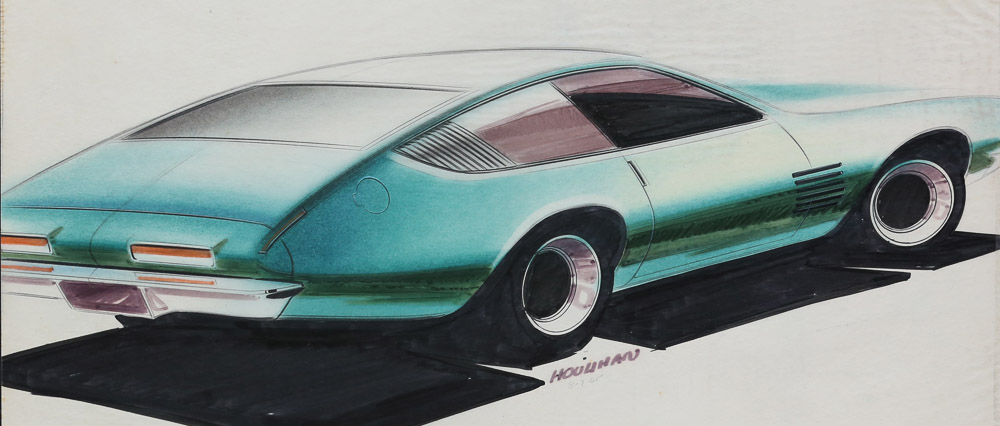
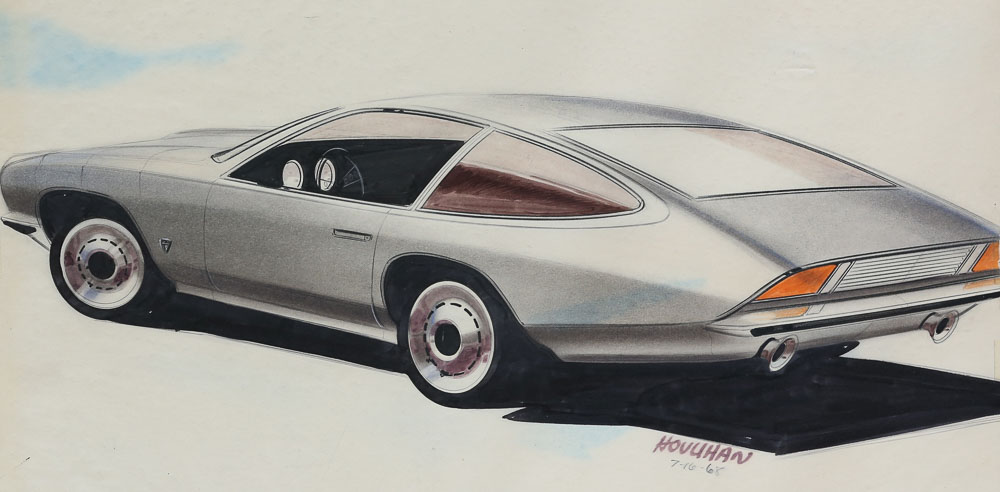
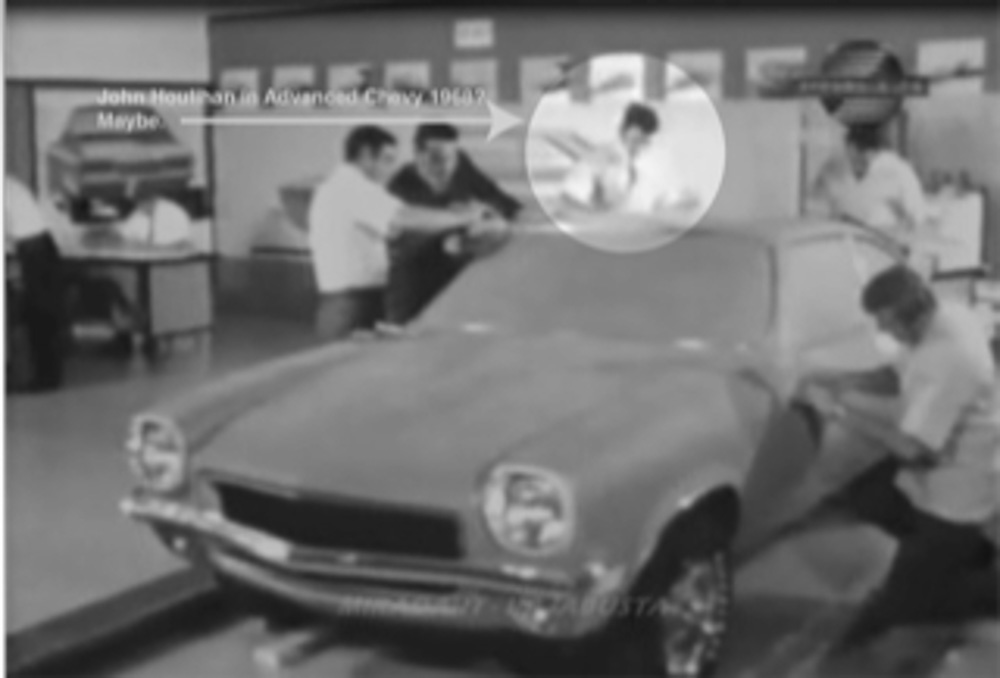
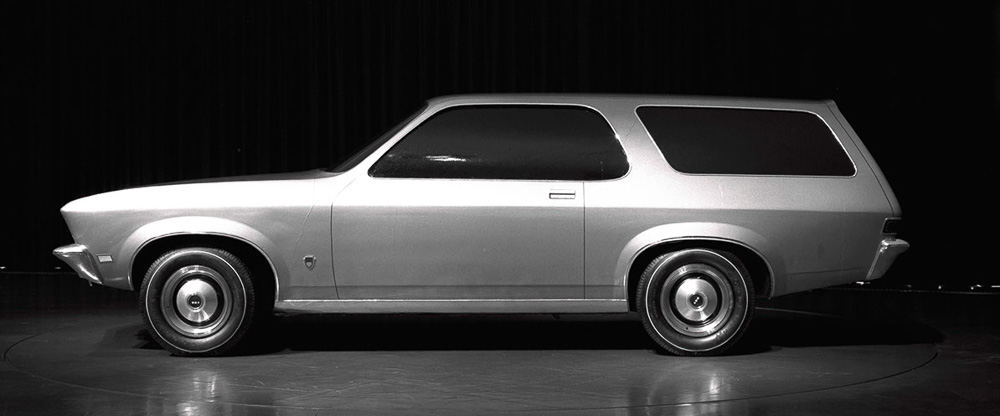
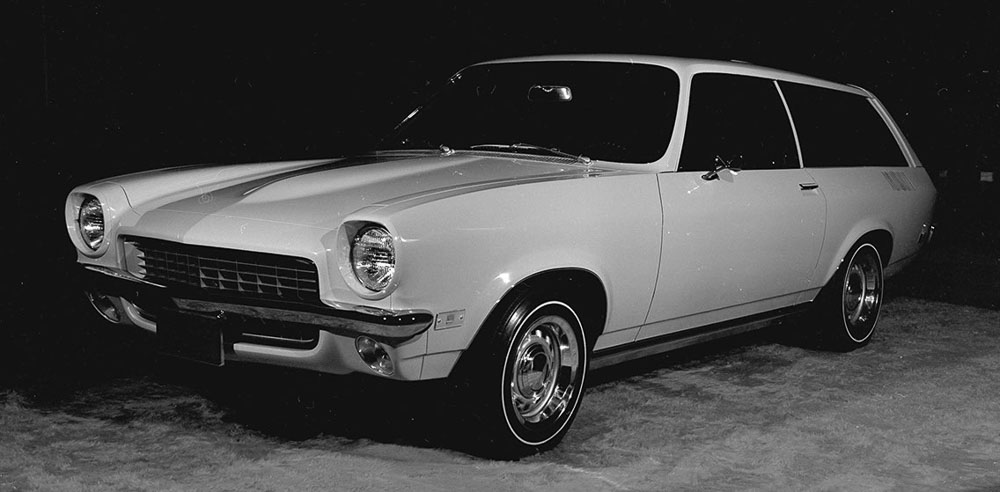
Why is the photograph so out of focus?
Because it is very small. It’s the best we have.—Gary
I always kind of liked the looks of this model, so I bought one new and took it on its maiden trip to visit friends in the upper peninsula of Michigan. In a few miles, we noticed a faint whine from the back of the car, which I ignored, of course. We made it, but the din grew worse and on the way back, the rear end screaming, it finally blew right at our escape exit to Gaylord, errant gear fragments from the shattered banjo housing strewn about, smoking, melting the black top. Subsequently the rear end blew up three (3) more times…yet, always in interesting places…so, there’s that.
The heater blasted hot, full-on, in August, regardless of the setting on the “for decorative purposes only” temperature dial. The service manager, highly trained in “abuse management” at the Chevy dealership said. “They all do that.” It was white, rusted out in a couple months so I rattle-can sprayed it and sold it to a young woman who was just starting college. I staged it in deep snow so the laciest sheet metal didn’t show too much. I have felt nearly bad about that for years.
Hi Gary. The first car I purchased was a ’73 Vega Kamback-white; customized it , drag raced it and never had a problem….loved it! Must have been a rare one.
Cheers, Bunker Hill Bradley, former Design Director of Nissan Australia (also, GM designer 11 years).
I don’t know which was more interesting, the article itself or Tom Semple’s and “Bunker Hill Bradley’s” commentary.
Houlihan’s sketches are nice and simple, conveying the initial theme strongly enough to cause interest and pursuit by his upper management. (What every designer seeks, right?)
Proof in the pudding comes out with the final product in production. I won’t comment on “build quality” as companies I worked for sure had their share.
However, the morphing of the design improved as it moved toward final sheetmetal as can be seen in the last photo.
Nice job, John
Great story John. I remember you going up on the roof of my garage to take pictures of the Mangusta.
I always thought that the Kammback was very clean, very nicely executed. Popular among drag racers because of the better weight distribution afforded by the extra body & glass in the rear and easier to tub for big slicks. They shoulda made a Cosworth version. That would have been fun. Quality problems and aluminum engine problems not withstanding, the Vega was a nice styling exercise, way more class than a Pinto. Interiors were a lot nicer too. If only they had gotten the powerplant straightened out first…
What I remember about this project was that the Vega was supposed to have amber rear turn signals, in keeping with the “European” theme. In the end though, Chevrolet undertook a big cost cutting effort and deleted the separate bulb required to achieve that feature. Since the tooling was already completed for the amber lens, they at least left them alone, so that it looked European as long as the turn signal weren’t working. Who knew that bean counters could be such effective stylists!?
My recollection of driving dozens of Vegas in the first couple years of production, as an aftermarket graphics painter for dealers, was how small they were inside. I was not a big guy at 6′ and 150lbs, but the interior packaging was only good for people under 5’6″! The Pinto and Gremlin had much better interior packaging.
My first Vega was bought new, a ’72 Wagon with a 4-speed. Never had a problem with the engine or any other mechanical part. I was an outside salesman and put over 60K miles in 2 1/2 years. There was nothing wrong with the engine that simple maintenance would take care of. I added a radiator overflow tank, a part that Chevy didn’t include, which cured the problem of over heating which led to virtually all the Vega engine failures. The small stock radiator, without the overflow tank, would quickly discharge most of the engine cooling liquid, leading to a badly over heated engine and scored cylinder walls and excessive oil consumption. The 60K mile mark was typically a point where you replaced the car in those days and mine was replaced with a ’74 Vega GT.
Wonderful account-I love origin stories! I never owned a Vega but loved the style of that wagon. A friend at Ford had a Hatchback that he drove mercilessly and had a ball with it. Too bad the build quality never matched the style.
While in high school, my son Mark brought first a Vega Coupe, and later, a Vega wagon (yes, HE bought them). I remember we repainted one with enamel and the other with lacquer. Of course, the front fenders rusted off one of the cars so Mark made a deal with the local dealer that instead of a 50/50 installation, he would take the fenders at no cost to him and mount them himself.
There was a young fellow at GM Research who was experimenting with various shapes in the wind tunnel to determine which had the lowest drag. Turned out the square back was the best and validated Dr. Kamm’s concept. The young man, whose name I cannot remember, left GM a short time later and joined another company, I believe in California.
Ken Pickering
Good story. Brought back good memories.
LOL!
Thank you for sharing these good story. Both drawings look like the future Chevy Monza.
I’m confused about the timeline of this event. The author states that he and his team were working on a new “European” stylistic approach for the XP-887, inspired heavily by the Fiat 124 Coupe, because the previous design concepts had been “too GM looking”. That resulted in the change to the definitive look for the production Vega, with its heavy Fiat 124 coupe influence.
But the wagon rendering (presumably by the author) and the photograph near the end of a caly of the same car clearly display the earlier “GM look” version of the XP-887, before it was changed to the Fiat/European style. So there is a major inconsistency in the story. Also, it seems odd that Cole would approve the tooling of the wagon when it was still in its earlier “GM look” incarnation. How would you tool up for a car that hasn’t been designed yet?
It seems to me that the timeline of this event was likely somewhat different then how the author remembers it. The evidence shows that the XP-887 wagon was approved early on, before the change in styling direction, so it wasn’t exactly a last-minute addition to the Vega line-up. Cars aren’t “tooled up” until their design is locked in, right? Or am I missing something?
Remember the Vega’s well. My first Vega was a used 1971 Wagon (thought it was a neat looking wagon). Had 45K miles on it and within a year the engine did just that, needed to be replace. But being a ‘Back Yard Mechanic’ and having had the 1961 Old’s with the 215 V8 so the engine was replaced with a Steel Sleeved Version of the engine and never had a problem after that for the next 4 years. Until it got totaled. Being at 70 and still liking to tinker with cars, as I had from the time I was 15, and thinking about the Vega Wagon Style I looked for a 1971-73 as that was the only neat styling of the Vega. I bought another 1972 GT Wagon with a 73 Steel sleeved engine and 4 speed. This was 10 year ago and it is still my daily driver, with 120K now and will continue to do so as long as I can kept it running. LOVE that ’70 Camaro Styling the Vega has when you cut the middle of the front bumper away.
That 3rd rendering looks an awful lot like a Bitter CD coupe. Coincidence?
Paul Niedermeyer is correct about the Fiat 125 Coupe reference. I know because I purchased the Dark Blue Fiat 125 Coupe after GM Design had finished their work on the Vega and had no further use for the car. The Fiat was a great car, but after a year or so, it rusted away before my very eyes. I parked inside of the GM Design garage and the salt on Michigan roads and the warm temperatures of the indoor garage did not mix well in the winter time. I had the Fiat repaired and sold it, but it was sure fun while I owned it!
BTW, the name “Vega” was coined by Ed Cole’s wife Dolly. Cole told us that after we saw him at the “Vega Clinic” in California.
Ken Pickering
I ordered a brand new 1973 Vega Kammback GT Medium Red (burgandy?) with White vinyl interior full power, A/C and automatic. Put astro mags on the white raised lettered tires. Thought it was the most beautiful small car America made. Still do.
I’ve owned two Vegas, a ’75 base Hatchback during high school in the late ’70s (with RPO L11 2-barrel, THM250 auto, a/c and AM radio), and years later, a ’76 GT Hatchback (also 2-barrel, 5-speed manual, a/c, and AM radio) that I drove for eleven years, from 93,000 miles to 218,000 miles. I only drove the first one for a year (I traded it on a brand new ’78 Audi Fox), so I can’t comment on its longevity, but the GT was very reliable, only breaking down twice – once, when the in-tank electric fuel pump died, and once when the ignition coil quit. Here in North Texas, rust isn’t an issue, so it wasn’t with Vegas. The engines (at least the later ones) were okay so long as you maintained the cooling system and didn’t let them overheat.
I have a version of it still. A 1978 Sunbird Safari Sport wagon. I love it. 2.5 liter Pontiac motor, with every option you could get except the Buick V-6. Turns lots of heads. I drive it every chance I get. Wish I could post a photo. I put the parts of a 76 Vega “NOMAD” package on it to make a “SAFARI” like the factory should have. Two tone silver paint from 1978 Bonneville coupe with rear over the roof paint break at rear. Car has won all sorts of awards.
My Scottish father-in-law purchased a new ’74 notchback – absolutely no options. After a few months it developed noise around both sides of the engine that turned out to be a blown head gasket. Why? The center six cylinder head bolts had been stolen while in the parking lot at his work. The long ones were unavailable so I had to use threaded rods to fab my own bolts. One had broken off at the block. Had to fab a super long drill to get it out. After 100,000 trouble-free miles it was traded in on a Chevette.
My brother had a Vega wagon (?) in the 70’s. He chopped the back roof to make it an El Camino (ute?) and gave it a small block Chev motor (327?).
Don’t remember what he did with it, but it went away eventually.
John,
Nice job, very clean design. We need that attitude in today’s automotive design.
Interesting that the Vega design was eventually influenced more by the upcoming Camaro front end than the Fiat. There’s a similar account of GM design adventures by another GM design exec who retired in Australia, Leo Pruneau. He taped the design that became the mid-late 60s Vauxhall Viva, a small car with a “coke-bottle” hip, while his bosses were at lunch. His profile of the car was inspired by the first Camaro.
It’s interesting that the original concept included a thicker B-pillar and hardtop styling with a small quarter window (that was intended to roll down?); I expect that was nixed for cost reasons. Too bad they couldn’t include Nomad-style sliding windows.
Have had many Vegas over the years. I never understood why they didn’t use the 1.9 liter opel engine. The 71-72 already used the Opel 4 speed. That engine was better than the 2.3 by far.
The Vega was an excellent idea with a lousy execution. I had a ’73 GT in college. Being in college, I gave a lot of rides to people who would say, “What a cool car. What is it?” They were flabbergasted when I said, “A Vega.” Really, if GM had spent as much fixing the overheating and rust problems as they did trying to convince us nothing was wrong, the car would have lasted through the ’70s.